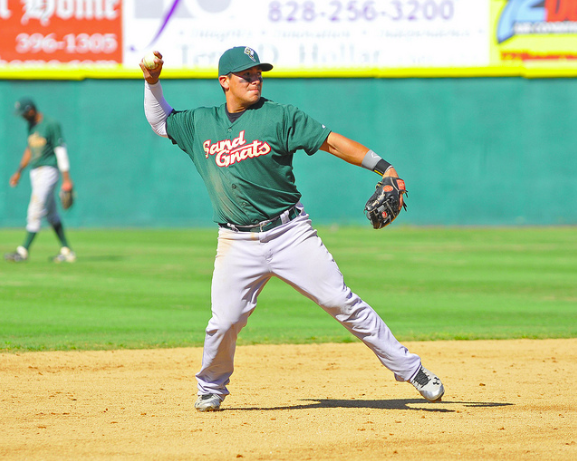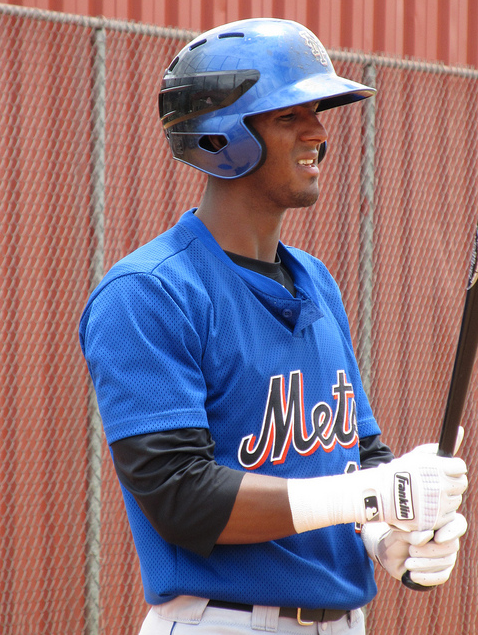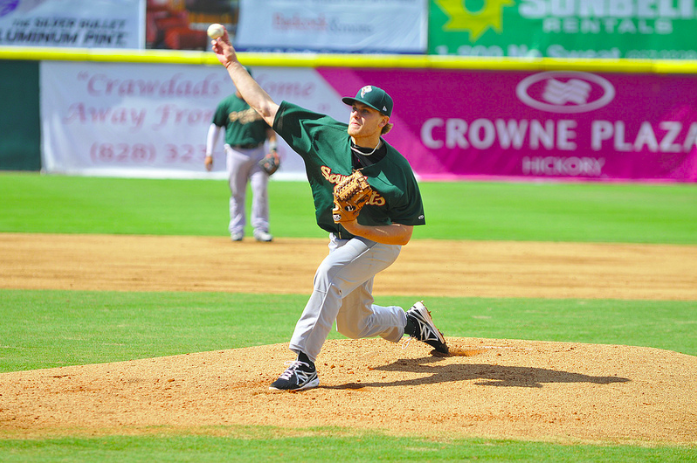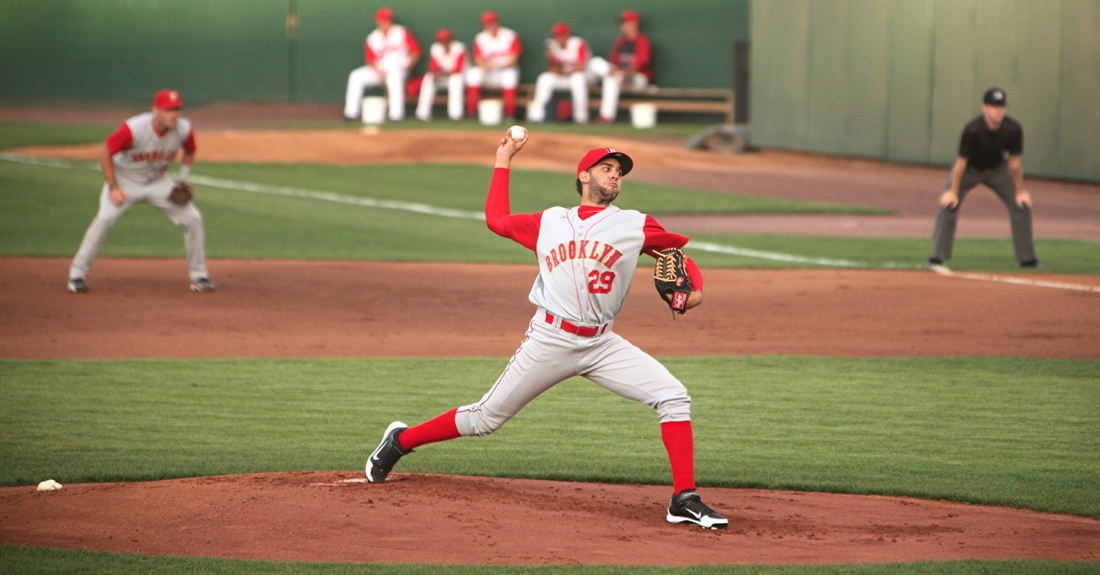
The Sand Gnats boasted a strong crop of pitching on their way to a South Atlantic League championship in 2013.
Our 2013 minor league season in review rolls on as we take a closer look at the Class-A Savannah Sand Gnats. (We've also reviewed the GCL Mets, Kingsport Mets, and the Brooklyn Cyclones.) It was a very successful year for the Gnats who not only found their way back to the playoffs after a one-year hiatus, but were finally able to capture a South Atlantic League title -- their first since 1996.
For a higher level look at the club and more on their outstanding 2013 campaign check out our recent affiliates overview. However, here we'll take a more in-depth look at the various prospects that played in Savannah last summer:
Hitters
Phillip Evans, SS
It was a brutal campaign for the high profile 24th-rounder, who more or less played himself out of serious prospect consideration in 2013. Despite his ability to make the highlight reel play at short, his uneven defensive play must now be graded as downright bad as the speed of the game often ate him up. Worse, his so-so bat took a big step backwards this year as he only managed a .203/.268/.263 line. Despite decent contact numbers and a surprisingly acceptable eye at the plate, he just doesn't seem to have the kind of hit tool to survive against more advanced professional pitchers. It's fair to presume that in a system with some more middle infield depth Evans would have been relegated to a secondary role in 2013 and that is exactly what could happen next season.
Dilson Herrera, 2B
In what's becoming a strength of his, Sandy netted yet another top prospect by way of trade when he sent Marlon Byrd and John Buck to Pittsburgh for Dilson Herrera -- and Vic Black -- just before the trade deadline. The 19-year-old Herrera appeared in only seven regular season games for the Sand Gnats, though he'll likely figure into organizational top ten prospect lists thanks to a strong bat paired with a true middle infield profile -- something the system has sorely lacked of late.
Herrera stamped his blue chip status in 2013 on the strength of a very quick bat, a good glove at second, above average footspeed, and most of all excellent pop from the right side despite his size (5'10", 150 lbs). The problem is that the diminutive infielder also features a healthy amount of swing-and-miss in exchange for that power, which will likely cut into the average as he climbs. It's still early on the development curve, but if Dilson can continue to move in the right direction, the long-term picture could resemble something like pre-2013 Danny Espinosa. As an aside, Herrera will also attempt to become the first Colombian in Mets history.
Brandon Nimmo, OF
It was an odd year for Nimmo, who clearly didn't light it up -- his final line was .273/.397/.359 with two home runs -- but still showcased the kind of offensive ability to give Mets fans at least some reason to be optimistic moving forward. In fairness, his season would likely grade as an incomplete as he experienced a lingering hand/wrist injury that put him on the shelf in May and clearly affected him throughout the summer. In fact, it's hard to take much away from his season aside from the fact that we'll have to wait and see more next year. He continued to showcase a fine eye at the plate and at points, the strong hit tool from the left side that had Mets brass excited to grab him in the first round in 2011.
That said, he struggled mightily at times, looking especially hopeless against lefties against whom he had just two extra-base hits all season. He also featured the highly worrisome combination of an egregiously high 27% strikeout rate and a woefully low .086 ISO in 2013. It's difficult to distinguish how much of that is real and what was the injury, as various reports had him looking off for long stretches of the summer. Again, there is little more to take from his season than the fact that we need to see more.
Eudy Pina, OF
The 22-year-old Dominican outfielder first caught our eye back in 2010, with a huge campaign in the Dominican Summer League. As we know, those stats can be deceiving and he hasn't been quite as good since. Still, he's been able to maintain an impressive athletic approach, showcasing a very strong power/speed mix in 2013. Not only did he steal a team-high 21 bases, he also led the Gnats with ten home runs (not counting Herrera, who hit all 11 of his with West Virginia). The righty generates excellent pop from his long, lanky frame; only three others have hit double-digit home runs in the power-suppressing atmosphere of Savannah since 2010 (noted power junkies Aderlin Rodriguez, Travis Taijeron, and Dustin Lawley). The problem is that the power comes with many strikeouts (23% each of the last two seasons) which threatens to eat up his value as he ascends, though he's countered them with very solid walk rates. There's enough going on here to remain interested to see what he does in St. Lucie in 2014.
Pitchers
Luis Cessa, RHP
The 21-year-old converted infielder took another big step forward after putting his name on the map in 2012 as a member of the outstanding Brooklyn staff. The former shortstop posted an excellent 3.16 ERA in his first full season as a starter, striking out a very strong 23% of batters while walking just 3.5% of them. The arm strength was no surprise from the former shortstop as he worked his fastball into the mid-90s; the command of that pitch, however, was quite surprising for someone with much less experience relative to his peers. Consider that he walked just three more batters than noted command aficionado Gabriel Ynoa. In fact, it's interesting how well Cessa's peripherals stack up against the organizational Sterling Award winner. While he doesn't have the same depth of secondary offerings, it's indicative that Cessa too may have a career at the big league level one day -- though probably as a reliever when all is said and done.
Julian Hilario, RHP
After a strong performance out of the Brooklyn rotation in 2012, Hilario appeared as the primary understudy for the strong Savannah staff making 30 relief appearances and five spot starts in 2013. He once again posted strong results, including a 3.77 ERA along with a strong 21% strikeout rate. In short, he's a big-bodied righty with a strong fastball and a good idea how to use it, though not much else. He's got to shore up the command and slider to have a chance as a reliever at the highest levels.
Matthew Koch, RHP
The Mets 2012 third-round selection, Koch (pronounced 'Cook') has been something of an enigma thus far in his pro career. In terms of the stuff, the big, strong righty has showcased the same low-to-mid 90s fastball that made him a very effective closer for the University of Louisville. What's more, his control has been off the charts (see, four walks in 80 innings pitched). And yet, after two seasons he has a 4.77 career ERA and he allowed opposing batters to hit nearly .300 off him in 2013 -- which tells you that he isn't really fooling anybody. The problem here is that the fastball is pretty straight, the secondary repertoire is suspect, and he has a hard time keeping balls down. Despite the organization's best efforts to stretch him back out, Koch looks like he’s destined to do his best work in the bullpen.
Steven Matz, LHP
2013 was a banner season for the big lefty as he was finally able to stay on the field. In fact, prior to '13 Matz had appeared in just six professional games, making his 21 starts for the Gnats last summer a revelation. That's because he showed us right away that the stuff that made him the Mets top selection back in 2009 is still as impressive as ever. In fact, despite the lack of reps his electric fastball seems to have even gained a tick or two, working into the high-90s from the left side. This allowed him to strike out nearly 30% of the batters he faced and though he'll have to work on his command, the fact that he allowed just 86 hits in 106 innings tells you all you need to know about the stuff.
For that reason, the Mets recently added Matz to their 40-man roster -- an irregular move considering the 22-year-old's distance from the majors. That said, it became clear very quickly that Matz is still a very special arm and someone that couldn't be risked in the Rule 5 draft. Based on his dominant performance in 2013, it's fair to say that despite standard issues about command, repeating his delivery, etc, if the Long Island native can stay healthy the ceiling is somewhere near the top of a major league rotation. In the nearer term, this is a player that could vie for the system's top spot by the middle of next summer.
Paul Sewald, RHP
The thinking when the Mets drafted Sewald in the tenth round in 2012 was that the University of San Diego senior would sign on the (very) cheap -- which he did -- and that he may see a bump with a move to the bullpen -- which he has. And 'bump' may be an understatement; he just posted his second consecutive season with a sub-two ERA and strikeout rate upwards of 30%. Most of all, the command issues that he had coming out of college have completely evaporated as he's walked just over 2% of batters since turning pro. The 22-year-old righty isn't necessarily known for his lights-out stuff; however, he features enough in the way of a classic college three-pitch mix, including an above-average slider. He'll likely slow once he reaches the middle levels of the minors, but at this point he has as good a shot for a middle relief career as anyone signed for $1,000.
Gabriel Ynoa, RHP
Ynoa was nothing short of the best pitcher on the Savannah staff this summer and one of the better players in the entire farm system in 2013, posting a 2.72 ERA with a preposterous 16 walks in over 135 innings pitched. After an impressive 2012 where he starred as the youngest starter on a standout staff in Brooklyn, he took the next step by showing that his superb command of strong stuff was more than enough for full-season baseball. In fact, with a fastball that lives in the low 90s and a very advanced secondary repertoire it's becoming clearer and clearer that the 20-year-old has a relatively strong chance to start games at the highest levels.
The problem here is that he doesn't boast any plus offerings. Though he currently generates some swing-and-miss by hitting his spots and fooling A-ball hitters with a highly advanced change-up, he likely will not be a strikeout artist against superior competition unless he finds a couple more ticks on a mostly average fastball. Therefore, the ceiling isn't necessarily at the top of a rotation. Instead, he figures in as more of a back-of-the-rotation innings eater, known more for his excellent command, well-developed off-speed mix, and excellent approach to pitching -- not unlike a Dillon Gee.
Beck Wheeler, RHP
Wheeler is nothing short of one of the biggest surprises in the Mets system right now. The strong-armed righty went undrafted following his senior season at UC Santa Barbara -- where he happened to play shortstop. Fortunately for Wheeler, one of his coaches knew a Mets scout who gave him a look, though as a pitcher despite the fact that he had only four collegiate appearances on the mound. Just two years later Wheeler was an SAL all-star as well as the closer for a championship Sand Gnats team in 2013, posting a 2.32 ERA with 74 strikeouts in just 50 innings pitched. Like a number of other Sand Gnats relievers, Wheeler has a real shot at the highest levels thanks to a good fastball that reportedly ticked into the mid-90s this summer as well as a forkball as effective as it is unorthodox.





